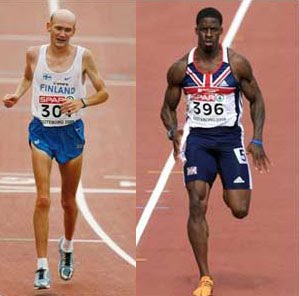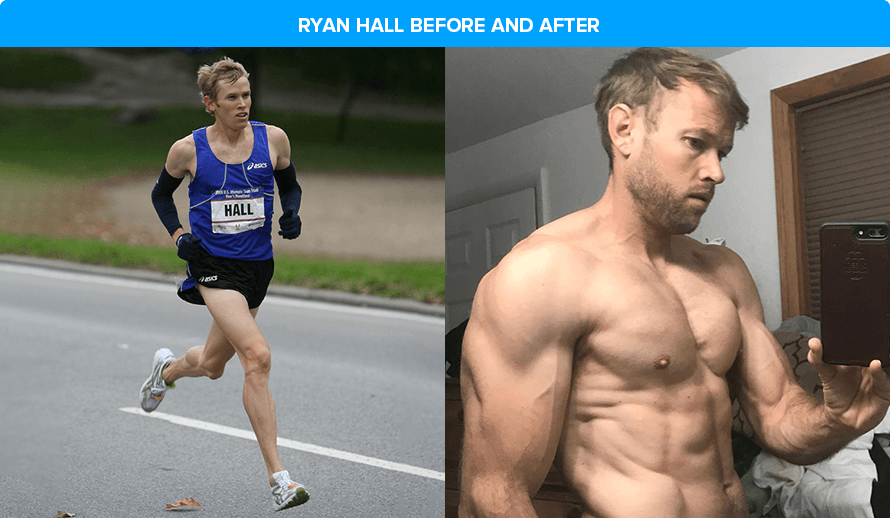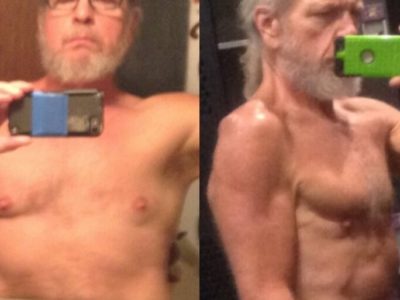
By many people’s lights, cardio is to muscle gain what garlic farts are to a first date.
Kryptonite.
Many guys and gals looking to build muscle avoid cardio like cigarette smoke, thinking that even a little whiff will kill their gains.
Others take avoiding cardio to absurd extremes (using the escalator instead of the stairs, for example, or asking a friend to walk their dog so they don’t “burn muscle”), and even many learned fitness experts rail against the perils of cardio.
Of course, many who enjoy lifting weights look at cardio like a drunk uncle who just collapsed on their porch—a responsibility they know they should take care of but would rather evade.
Thus, when their favorite TikTok fitness tubthumper tells them that if they want to build muscle, they need to stop doing cardio, they jump on it.
The idea that cardio burns muscle is contagious: it provides a sCiEnTiFiC justification for shirking an activity many people don’t like (cardio), it’s simple and catchy, and it even contains a kernel of truth. And like many virulent fitness conventions, it’s also false.
In this article, you’re going to learn what scientific research has to say about questions like . . .
- Does cardio really burn muscle?
- Does fasted cardio burn muscle?
- Should you do cardio while bulking?
- How much cardio is too much?
Let us begin.
How Cardio Can “Burn” Muscle
When people say cardio “burns” muscle, what they really mean is that cardio breaks down the contractile proteins that make up your muscles.
And they’re partly right. Cardio can burn muscle . . . if you do almost everything wrong with your diet and training.
In a way, saying that cardio burns muscle, with no exceptions, is like saying that credit cards ruin your finances.
Kind of true for many people? Yes.
Misleading and facile to the point of being wrong? Also yes.
As you’ll learn in this article, cardio won’t hamper your gains if you eat and train properly. What’s more, it’ll improve your cardiovascular health, reduce your risk of heart disease, cancer, and cognitive decline, make it easier to get (and stay) lean, and possibly even improve your performance in the gym.
In other words, if you’re making the mistakes covered in the next few paragraphs, you will gain more muscle and strength if you stop doing cardio entirely. However, if you stop making these mistakes, you can (and probably should) do cardio without scuppering your gains.
The top six reasons people think cardio burns muscle are because they do. . .
- Cardio instead of lifting weights.
- Cardio as part of a crash diet.
- Too much running.
- Too much total cardio.
- Too much cardio at one time.
- Exhausting cardio immediately before, during, or after lifting weights.
Mistake #1: Doing cardio instead of lifting weights.
Although many people blame cardio for causing muscle loss, a lack of weightlifting is more accurately to blame.
For example, one of many fitness gurus’s perennial red herrings is to compare pictures of marathon runners and sprinters. “Hurr durr which would you rather look like LOL? #nocardio #positivevibesonly #pumpedAF” This sophistic line of reasoning is how you get pictures like these:


Their argument is that if you do traditional, low-intensity cardio (like marathon runners), you’re going to look like a scraggy wraith. If you lift weights and do very little cardio (like sprinters), you’ll look like a bodybuilder.
Of course, this inane argument ignores several facts:
- Many endurance athletes don’t lift weights. Or if they do, they do so with light weights, high-reps, and infrequently or inconsistently.
- Most elite endurance athletes train far, far more than even competitive recreational athletes. For example, champion marathoners run up to 160 miles per week—over 20 miles per day! That’s a far cry from what most people do to get fit.
- Most elite endurance athletes have a borderline–unhealthy obsession with maintaining a low body weight (especially long-distance runners). They often severely restrict their calorie intake to ensure they don’t gain weight (either fat or muscle), as this reduces their performance.
- Most sprinters, and certainly the ones who look like IFBB pros, are on all kinds of steroids (Winstrol, testosterone, Deca-Durabolin, you name it). They also spend a good chunk of their time lifting weights, as the additional muscle mass and strength improves their performance, whereas this isn’t true for most endurance athletes.
Basically, the only thing these comparison pictures prove is that running marathons, severely restricting your calorie intake, and not lifting weights is a recipe for staying small.
The real question is what happens if an endurance athlete starts eating and lifting weights in a way that’s conducive to muscle gain?
Instead of answering this question myself, I’ll let Ryan Hall do so. Hall is a retired elite-level runner, who currently holds the U.S. record for the half marathon and is the only American to ever run a sub-2:05 marathon. Like most endurance athletes, Hall didn’t lift weights, spent most of his time running, and meticulously controlled his calorie intake to ensure he stayed skinny, light, and speedy.
In 2016, Hall retired from competitive running and started weightlifting. Not tottering on Bosu balls or doing planks till he was blue in the face—but heavy, compound weightlifting.
And here’s what happened:

“But doesn’t this prove that cardio burns muscle? He only got big after he threw away his running shoes!”
Nope.
Hall still runs every week (with the amount depending on his current goals and schedule), and even occasionally races.
The lesson?
Doing lots of cardio at the expense of proper weightlifting can burn muscle, but this is an easy mistake to avoid. Instead, lift weights too. (And before you cry “steroids,” read this article and ask yourself if Hall’s transformation raises any red flags. Methinks not.)
Mistake #2: Doing cardio as part of a crash diet.
Most people who do lots of cardio aren’t elite endurance athletes like Ryan Hall. Instead, the prototypical cardio junkie uses large amounts of cardio in combination with a crash diet to lose weight as fast as possible.
And this works extremely well.
For example, a study published in the Scandinavian Journal of Medicine & Science in Sports had fifteen overweight men follow a diet that provided just 10% of their calorie needs per day for four days. Here’s the kicker: they also had them exercise nine hours per day—eight hours (20 miles) of walking followed by 45 minutes of arm cranking.
Sure as death and taxes, they lost a boatload of body fat—almost five pounds in four days.
The catch is that they also lost about a pound of muscle.
Of course, this is an extreme example, but many people follow a milder version of this protocol for several weeks or months, instead of for four days. For example, it’s not uncommon to find people who cut their calorie intake in half (a 50% calorie deficit) and do an hour or more of cardio per day for several weeks to drop weight.
While they lose weight quickly, they also usually wind up losing large amounts of muscle and looking skinny fat.
And when this happens, people often blame cardio.
Never mind the extreme calorie restriction (which causes muscle loss even if you don’t exercise) or lack of protein. It was all cardio’s fault.
Mmmhmm. Sure.
Just like getting in debt is all the fault of your Amazon Rewards Visa.
The bottom line is that extreme calorie restriction of any sort—whether it’s achieved through eating less, doing lots of cardio, or a combination of both—causes muscle loss, amplified several times over if you don’t lift weights.
This is the fault of reckless calorie restriction—not cardio.
Mistake #3: Running too much.
Does running burn muscle?
Sort of.
It’s true that of all the kinds of cardio, running seems to be uniquely inimical to gaining muscle (hypertrophy).
Running causes more muscle damage than other forms of cardio, like cycling, rowing, and rucking, which interferes with muscle gain in two ways:
- It significantly increases muscle protein breakdown during and after runs, which makes it harder for your body to build new muscle proteins.
- It causes disproportionately more fatigue than other kinds of exercise, which can interfere with your strength training workouts.
That said, as our chum Ryan Hall proves, this doesn’t mean any amount of running will hurt your progress.
For instance, one of the first studies on this topic had one group of people follow a five-day-per-week strength training program and another group follow the same strength training program as well as three vigorous running and three cycling workouts per week.
They found that the people who did both strength training and cardio gained almost the same amount of muscle as the people who only lifted weights. Many other studies that have combined running and weightlifting have found the same thing.
Thus, the anecdotal and scientific evidence is clear: running doesn’t burn muscle, but running too much can interfere with your gains. You can avoid this, though, by limiting your weekly running mileage and properly planning your runs around your weightlifting workouts.
Specifically, a good rule of thumb is to do no more than two-to-three hours of running per week, and make sure you do your running and lower-body weightlifting on separate days.
Mistake #4: Doing too much total cardio.
Even if you do most things right—you lift weights, eat enough calories and protein, get plenty of sleep, and separate most of your cardio and weightlifting workouts—cardio can still retrench muscle gain if you do too much.
Your body can only recover from so much exercise per week, and if you’re already lifting weights three-to-five times per week, it’s only logical that adding an equal amount of cardio on top of this is going to throw some sand in your gears.
Some people misconstrue this to mean that “the more cardio you do, the harder it will be to build muscle,” but this is incorrect.
Research shows that so long as you’re following a proper diet and strength training program, you can gain muscle just as effectively doing a few hours of cardio per week as you can when only lifting weights.
Doing more than this doesn’t burn muscle, but it does retard muscle growth to a certain extent.
Once again, though, the rub isn’t cardio as a whole—it’s simply doing too much. The dose makes the poison (if you can call something that improves your health in nearly every way a poison).
Mistake #5: Doing too much cardio at one time.
In addition to how much total cardio you do per week, the duration of your cardio workouts also affects your ability to build muscle.
Most studies have shown that an effective way to avoid the negative effects of cardio on muscle growth is to limit most of your workouts to less than an hour. Keep in mind that doing more than an hour doesn’t automatically “trigger” muscle breakdown, but simply increases the risk of impeding your ability to build muscle.
Further evidence for this strategy comes from studies on natural bodybuilders, who often do several 30-to-40-minute cardio workouts per week without losing any muscle to speak of.
As Dr. Mike Zourdos, an Associate Professor at Florida Atlantic University puts it, “cycling a couple times per week for 30 minutes at a moderate intensity has been shown to have absolutely no negative effect on hypertrophy and strength gains.”
Thus, so long as you keep most of your cardio workouts under an hour, you don’t need to worry about burning muscle.
Mistake #6: Doing exhausting cardio immediately before, during, or after lifting weights.
Finally, the last mistake many people make when combining weightlifting and cardio is combining both kinds of training in the same workout.
For instance, many people will do 30 minutes or so of cardio immediately before or after weightlifting, and others interweave bouts of weightlifting and cardio in the same workout (such as CrossFit or circuit training).
None of these strategies are ideal.
Doing cardio immediately or even several hours before lifting weights makes it difficult to perform at your best in the gym, which usually results in less muscle growth over time.
Doing cardio immediately after lifting weights is less detrimental, but can also interfere with muscle growth by dampening some of the anabolic (muscle-building) signals from strength training.
We don’t need to get into the particulars of how this works, but it’s generally best to refrain from cardio immediately after lifting weights to allow the adaptations from strength training to sink in.
That said, if the only time you can do cardio is right after lifting, don’t sweat it. Research shows that as long as you keep your cardio workouts fairly short and low-intensity, this shouldn’t get in the way of muscle building.
Finally, mixing cardio and strength training in the same workout (circuit training) will generally reduce your performance at both, thus reducing your gains over time.
Again, none of this means that cardio burns muscle, but doing it at the wrong times can meddle with your body’s muscle-building mechanisms.
Remember too that not all cardio is equally problematic. Walking 10-to-20 minutes to the gym is not going to hurt your gains. Doing an intense 30-minute HIIT workout and then clomping from the treadmill to the squat rack will.
The Right Way to Combine Cardio and Strength Training
So, does cardio really burn muscle?
No.
If you do cardio incorrectly, it can slow your rate of muscle growth by interfering with your strength training workouts and dampening the anabolic effects of weightlifting. But it won’t make you lose muscle if you sidestep these blunders, which is easy to do.
Like the credit card analogy, cardio can cause problems if you don’t know how to use it properly. Use it wisely, though, and you can reap many rewards.
Here’s how:
- Prioritize low-impact forms of cardio like cycling, rowing, skiing, and rucking.
- Limit the volume and duration of your cardio workouts to no more than 30-to-45 minutes per cardio workout and two-to-three hours of total cardio per week.
- Separate your cardio and strength training workouts by as much time as possible, and try to avoid training the same muscle group with both weightlifting and cardio on the same day (such as squats in the morning and running in the afternoon).
Do those three things, and cardio should have more or less no negative effects on your ability to gain muscle.
Ultimately, cardio doesn’t have to interfere with muscle gain if you implement it properly. At bottom, the reason cardio has earned a bad rap is due to user error, not because cardio kills your gains.
If you want to learn more about how to combine strength training and cardio without interfering with muscle gain, check out this Legion article:
Concurrent Training: The Right Way to Combine Cardio and Strength Training
FAQ #1: Does fasted cardio burn muscle?
Fasted cardio involves intentionally doing cardio after your last meal has fully digested (usually at least five-to six hours or so).
While fasted cardio does increase fat burning during your workout, it causes two problems:
- You burn less fat during the rest of the day, which means you lose the same amount of total body fat over a 24-hour period as you do after fed cardio.
- Your risk of muscle loss rises.
The main reason fasted cardio can cause muscle loss is that it quickly depletes muscle glycogen levels, and when this happens, the body begins to break down protein (muscle) for energy.
However, you generally have to do a fair amount of cardio—at least 60 minutes or more—to deplete glycogen levels. Thus, your risk of losing muscle after a short ~30-ish minute fasted cardio workout is minimal.
If you want to learn more about the pros and cons of fasted cardio and the one situation where it can be useful, check out this article:
What Is Fasted Cardio and Can It Help You Lose Weight?
FAQ #2: Does high-intensity cardio burn muscle?
No, at least not any more than regular cardio, so long as you aren’t making the mistakes listed above.
While some people claim that high-intensity cardio is less likely to burn muscle, the evidence for this is spotty. Some studies show that high-intensity cardio interferes with muscle growth more than traditional, low-intensity cardio, and others show the opposite.
While studies haven’t provided a definitive answer to this question, there’s good reason to think that high-intensity cardio may be slightly more likely to interfere with muscle growth than low-intensity cardio. The main reason for this is that high-intensity cardio tends to cause more muscle damage and fatigue than low-intensity cardio, which can interfere with your strength training workouts and reduce muscle gain over time.
Thus, high-intensity cardio doesn’t burn muscle, but you’re probably better off opting for low-intensity cardio most of the time if your main goal is to get swole.
FAQ #3: How much cardio is too much?
There’s no hard and fast rule about how much cardio you should do, as the answer depends on your goals, preferences, and recovery abilities.
That said, if your primary aim is building muscle, here are a few rules of thumb that tend to work well for most people:
- Limit the time you spend doing cardio to no more than half the amount of time you spend weightlifting each week. For instance, if you lift weights for four hours per week, don’t do more than two hours of cardio.
- Limit the duration of most of your cardio workouts to 30-to-45 minutes, only doing more than this if you enjoy it or if you want to significantly improve your endurance.
- Don’t do more than one HIIT cardio workout per week. If you want to do more cardio than this, do the rest of your workouts as low-intensity cardio.
FAQ #4: Should you do cardio while bulking?
You don’t need to do cardio while bulking, but it’s a good idea for several reasons:
- Cardio offers many health benefits that are difficult to get from weightlifting alone, such as greater decreases in blood pressure and cholesterol and improvements in blood vessel health.
- Cardio may help you recover faster between sets during your weightlifting workouts, which could improve your gains over time.
- Cardio improves your body’s ability to burn fat, which may make it easier to lose fat when it’s time to start cutting again.
- Likewise, doing cardio while bulking helps you stay in the habit of doing cardio, which makes it easier to jump back into it when you want to get lean again.
- Cardio can be fun. If you enjoy it, there’s no reason to avoid hiking, cycling, skiing, and even some running while bulking, as long as you don’t make the mistakes listed earlier in this article.
+ Scientific References
- Purdom, T., Kravitz, L., Dokladny, K., & Mermier, C. (2018). Understanding the factors that effect maximal fat oxidation. In Journal of the International Society of Sports Nutrition (Vol. 15, Issue 1). BioMed Central Ltd. https://doi.org/10.1186/s12970-018-0207-1
- Sabag, A., Najafi, A., Michael, S., Esgin, T., Halaki, M., & Hackett, D. (2018). The compatibility of concurrent high intensity interval training and resistance training for muscular strength and hypertrophy: a systematic review and meta-analysis. Journal of Sports Sciences, 36(21), 2472–2483. https://doi.org/10.1080/02640414.2018.1464636
- Howatson, G., & Milak, A. (2009). Exercise-induced muscle damage following a bout of sport specific repeated sprints. Journal of Strength and Conditioning Research, 23(8), 2419–2424. https://doi.org/10.1519/JSC.0b013e3181bac52e
- Wilson, J. M., Marin, P. J., Rhea, M. R., Wilson, S. M. C., Loenneke, J. P., & Anderson, J. C. (2012). Concurrent training: A meta-analysis examining interference of aerobic and resistance exercises. Journal of Strength and Conditioning Research, 26(8), 2293–2307. https://doi.org/10.1519/JSC.0b013e31823a3e2d
- Fyfe, J. J., Bishop, D. J., & Stepto, N. K. (2014). Interference between concurrent resistance and endurance exercise: Molecular bases and the role of individual training variables. In Sports Medicine (Vol. 44, Issue 6, pp. 743–762). Adis International Ltd. https://doi.org/10.1007/s40279-014-0162-1
- Lemon, P. W. R., & Mullin, J. P. (1980). Effect of initial muscle glycogen levels on protein catabolism during exercise. Journal of Applied Physiology Respiratory Environmental and Exercise Physiology, 48(4), 624–629. https://doi.org/10.1152/jappl.1980.48.4.624
- Paoli, A., Marcolin, G., Zonin, F., Neri, M., Sivieri, A., & Pacelli, Q. F. (2011). Exercising fasting or fed to enhance fat loss? Influence of food intake on respiratory ratio and excess postexercise oxygen consumption after a bout of endurance training. International Journal of Sport Nutrition and Exercise Metabolism, 21(1), 48–54. https://doi.org/10.1123/ijsnem.21.1.48
- Schoenfeld, B. (2011). Does cardio after an overnight fast maximize fat loss? Strength and Conditioning Journal, 33(1), 23–25. https://doi.org/10.1519/SSC.0b013e31820396ec
- Vieira, A. F., Costa, R. R., Macedo, R. C. O., Coconcelli, L., & Kruel, L. F. M. (2016). Effects of aerobic exercise performed in fasted v. fed state on fat and carbohydrate metabolism in adults: A systematic review and meta-analysis. British Journal of Nutrition, 116(7), 1153–1164. https://doi.org/10.1017/S0007114516003160
- Schumann, M., Küüsmaa, M., Newton, R. U., Sirparanta, A. I., Syväoja, H., Häkkinen, A., & Häkkinen, K. (2014). Fitness and lean mass increases during combined training independent of loading order. Medicine and Science in Sports and Exercise, 46(9), 1758–1768. https://doi.org/10.1249/MSS.0000000000000303
- Davitt, P. M., Pellegrino, J. K., Schanzer, J. R., Tjionas, H., & Arent, S. M. (2014). The effects of a combined resistance training and endurance exercise program in inactive college female subjects: Does order matter? Journal of Strength and Conditioning Research, 28(7), 1937–1945. https://doi.org/10.1519/JSC.0000000000000355
- Baar, K. (2014). Using Molecular Biology to Maximize Concurrent Training. In Sports Medicine (Vol. 44, Issue Suppl 2, pp. 117–125). Springer International Publishing. https://doi.org/10.1007/s40279-014-0252-0
- Murach, K. A., & Bagley, J. R. (2016). Skeletal Muscle Hypertrophy with Concurrent Exercise Training: Contrary Evidence for an Interference Effect. In Sports Medicine (Vol. 46, Issue 8, pp. 1029–1039). Springer International Publishing. https://doi.org/10.1007/s40279-016-0496-y
- E R Helms, P J Fitschen, A A Aragon, J Cronin, & B J Schoenfeld. (n.d.). Recommendations for natural bodybuilding contest preparation: resistance and cardiovascular training – PubMed. Retrieved May 13, 2021, from https://pubmed.ncbi.nlm.nih.gov/24998610/
- Kilen, A., Bay, J., Bejder, J., Breenfeldt Andersen, A., Bonne, T. C., Larsen, P. D., Carlsen, A., Egelund, J., Nybo, L., Mackey, A. L., Olsen, N. V., Aachmann-Andersen, N. J., Andersen, J. L., & Nordsborg, N. B. (2020). Impact of low-volume concurrent strength training distribution on muscular adaptation. Journal of Science and Medicine in Sport, 23(10), 999–1004. https://doi.org/10.1016/j.jsams.2020.03.013
- D G Sale, I Jacobs, J D MacDougall, & S Garner. (n.d.). Comparison of two regimens of concurrent strength and endurance training – PubMed. Retrieved May 13, 2021, from https://pubmed.ncbi.nlm.nih.gov/2381303/
- Schumann, Moritz, & Rønnestad, B. R. (n.d.). Concurrent Aerobic and Strength Training – Scientific Basics and Practical Applications | Moritz Schumann | Springer. Retrieved May 13, 2021, from https://www.springer.com/gp/book/9783319755465
- Hickson, R. C. (1980). Interference of strength development by simultaneously training for strength and endurance. European Journal of Applied Physiology and Occupational Physiology, 45(2–3), 255–263. https://doi.org/10.1007/BF00421333
- Millet, G. Y., & Lepers, R. (2004). Alterations of Neuromuscular Function after Prolonged Running, Cycling and Skiing Exercises. In Sports Medicine (Vol. 34, Issue 2, pp. 105–116). Sports Med. https://doi.org/10.2165/00007256-200434020-00004
- Cava, E., Yeat, N. C., & Mittendorfer, B. (2017). Preserving healthy muscle during weight loss. In Advances in Nutrition (Vol. 8, Issue 3, pp. 511–519). American Society for Nutrition. https://doi.org/10.3945/an.116.014506
- Calbet, J. A. L., Ponce-González, J. G., Pérez-Suárez, I., de la Calle Herrero, J., & Holmberg, H. C. (2015). A time-efficient reduction of fat mass in 4 days with exercise and caloric restriction. Scandinavian Journal of Medicine and Science in Sports, 25(2), 223–233. https://doi.org/10.1111/sms.12194
- Bolger, R., Lyons, M., Harrison, A. J., & Kenny, I. C. (2015). Sprinting performance and resistance-based training interventions: A systematic review. In Journal of Strength and Conditioning Research (Vol. 29, Issue 4, pp. 1146–1156). NSCA National Strength and Conditioning Association. https://doi.org/10.1519/JSC.0000000000000720
- Kampouri, D., Kotopoulea-Nikolaidi, M., Daskou, S., & Giannopoulou, I. (2019). Prevalence of disordered eating in elite female athletes in team sports in Greece. European Journal of Sport Science, 19(9), 1267–1275. https://doi.org/10.1080/17461391.2019.1587520
- Reel, J. J., Petrie, T. A., SooHoo, S., & Anderson, C. M. (2013). Weight pressures in sport: Examining the factor structure and incremental validity of the weight pressures in sport – Females. Eating Behaviors, 14(2), 137–144. https://doi.org/10.1016/j.eatbeh.2013.01.003
- Karrer, Y., Halioua, R., Mötteli, S., Iff, S., Seifritz, E., Jäger, M., & Claussen, M. C. (2020). Disordered eating and eating disorders in male elite athletes: A scoping review. In BMJ Open Sport and Exercise Medicine (Vol. 6, Issue 1). BMJ Publishing Group. https://doi.org/10.1136/bmjsem-2020-000801
- Tjelta, L. I. (2016). The training of international level distance runners. In International Journal of Sports Science and Coaching (Vol. 11, Issue 1, pp. 122–134). Multi-Science Publishing Co. Ltd. https://doi.org/10.1177/1747954115624813
If you enjoyed this article, get weekly updates. It’s free.
Sending…
Great! You’re subscribed.
100% Privacy. We don’t rent or share our email lists.





